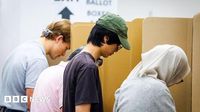Australians are casting their final votes on Saturday, May 3, 2025, in a national election campaign dominated by pressing cost-of-living concerns and a housing shortage. The ruling centre-left Labor Party, led by incumbent Prime Minister Anthony Albanese, is favored to secure a majority government according to a recent YouGov poll. Albanese is facing off against Peter Dutton, the leader of the center-right Liberal Party, who aims to become the first political leader to oust a first-term government since the Great Depression in 1931.
As the polls opened, it was reported that 8.6 million ballots had already been cast from Australia’s 18.1 million registered voters since early and postal voting began on April 22. Voting across the nation, which spans three time zones, will continue from 8 a.m. until 6 p.m. in eastern Australia, with the polls closing two hours later on the West Coast. Australia’s compulsory voting system ensures high turnout rates, with 90% of eligible voters participating in the last election.
The backdrop of this election is a cost-of-living crisis that both major parties have been keen to address. Inflation peaked at 7.8% shortly after the Labor government took office in 2022, and the central bank’s benchmark interest rate has risen from a record low of 0.1% to 4.35% as of November 2023. In February 2025, the central bank reduced the inflation rate by a quarter percentage point to 4.1%, indicating that the worst may be over, although economic uncertainty persists due to international factors, including U.S. President Donald Trump’s recent tariff policies.
On the campaign trail, Albanese's government has promoted itself as a steady pair of hands amidst global economic turbulence, pointing to a recent decline in inflation to 2.9%, the lowest since December 2021. Dutton, however, has consistently questioned whether voters feel better off than they did three years ago, positioning the Liberal Party as the solution to getting the country “back on track” after three years in opposition.
The competition for young voters has intensified, as this election marks the first time that younger demographics will outnumber Baby Boomers in Australia. Political communication expert Andrea Carson from La Trobe University noted that platforms like Instagram and TikTok have become crucial in reaching this audience, shifting the dynamics of political campaigning. However, the absence of regulations requiring truth in political advertising has led to a proliferation of misleading claims against opponents.
In a notable endorsement, Julian Assange, the founder of WikiLeaks, expressed support for Albanese, stating that the Prime Minister had done more for his freedom than any other politician. This endorsement, shared via social media by Assange's brother, comes after Assange's release from a British prison and his return to Australia. Albanese, however, downplayed the significance of the endorsement, expressing gratitude that Assange is now able to be with his family.
As voting continues, analysts are paying close attention to the potential for a shift away from the traditional two-party system. Recent elections have seen a growing proportion of votes going to independents and minor parties, with 35 Teal candidates—independents advocating for integrity and climate action—competing this year. This trend raises questions about whether the results from the 2022 elections, which saw the Liberal-National Coalition ousted after nine years in power, might signal a longer-term change in Australian politics.
Both major parties have promised to ease the housing crisis, with proposals aimed at helping first-home buyers enter the market. Dutton’s coalition is advocating for the construction of seven nuclear power stations to meet energy demands, while Labor aims for 82% of the energy grid to be powered by renewables by 2030. Despite this, Labor has faced criticism for approving new coal and gas projects even as it escalates its renewable energy initiatives.
As the day progresses, the political landscape remains uncertain. Commentators are watching to see if either major party can secure a majority in the 150-member House of Representatives, where Labor currently holds a narrow majority of 78 seats. The last polls are set to close at 6 p.m. local time, with results expected shortly thereafter. If the trend of declining support for the two major parties continues, Australia could see the emergence of a minority government, a rare occurrence in its political history.
Ultimately, the outcome of this election could reshape the future of Australian politics, reflecting the changing demographics and evolving voter sentiments in a nation grappling with economic challenges. As voters head to the polls, the stakes are high, with both major parties and a host of independents vying for the support of a nation seeking effective solutions to its pressing issues.





